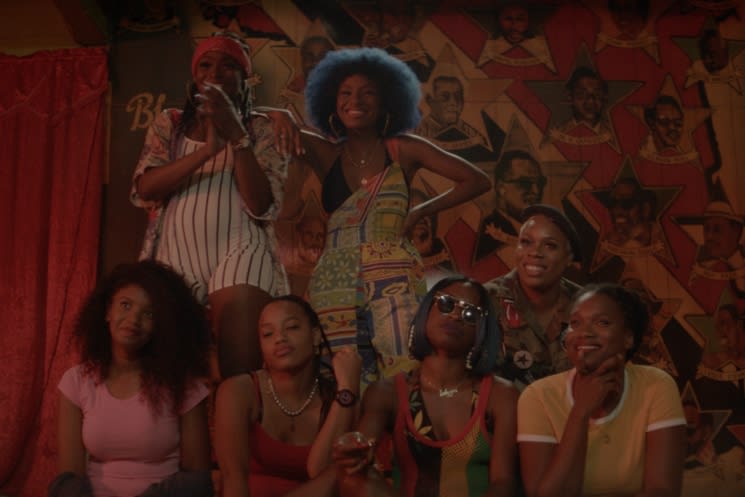Maya Cozier's feature debut, She Paradise — based on the short film of the same name — takes us inside the world of soca dancers in Trinidad. We follow Sparkle (Onessa Nestor), a young innocent girl who lives with her grandfather, Papa (Michael Cherrie). When an opportunity arises to earn some money by joining a dance troupe in time for Carnival, Sparkle jumps at the chance, much to Papa's dismay.
After overcoming the initial rejection of the group, Sparkle is soon brought into a tight crew led by Diamond (Kimberly Crichton). Along with Diamond, Mica (Chelsey Rampsersad) and Shan (Denisia Latchman), Sparkle auditions for a local musician, Skinny (Kern Mollineau), to dance in his music video. As Sparkle further ingratiates herself into the dance scene, she is forced to confront where this new life will take her.
In the lead role, Nestor's performance is subtle. She plays up the innocence of Sparkle well, while showing hints of the tenacity she hopes to embody. Despite a good portrayal, Nestor is let down by a script light on backstory and character motivation, leaving little for audiences to connect with.
As a filmmaker, Cozier excels in her choices. One particular shot of Sparkle practicing her dance routine overlooking the city is beautiful and raw. The dance sequences are lively and bring energy to the film — there's little doubt that Cozier's background as a dancer and choreographer benefitted She Paradise greatly. The way Cozier moves the camera around the dancers is frenetic at times, emphasizing the unrestrained exuberance of the girls, and at other moments is very measured, mirroring the precision required in dance nicely.
Key to Cozier's film is the spotlight given to the athleticism and sensuality of each dance move. Forgoing any crude objectification of the women, Cozier gives the audience a respectful perspective without dampening the seductive and uninhibited nature of soca.
Cozier doesn't shy away from telling a story with difficult subject matter. Not only does she put Sparkle in threatening situations, the reaction of her peers is harsh and unforgiving. Diamond and her crew have little time or patience for Sparkle's victimhood. They have been numbed to their own pain and are simply looking to survive. It's a controversial perspective steeped in truth.
She Paradise's ending may be more realistic than we're comfortable with. It forces the audience to confront their complicity in perpetuating problematic behaviour. However, what is missing from this important discussion is a strong statement from the filmmaker.
While degrees of ambiguity are sorely lacking and needed in many movies, She Paradise could have been vastly improved with a definitive conclusion to the themes broached. Rather than sending a bold message, She Paradise feels like it sits on a possibly problematic fence.
(Vortex Media)After overcoming the initial rejection of the group, Sparkle is soon brought into a tight crew led by Diamond (Kimberly Crichton). Along with Diamond, Mica (Chelsey Rampsersad) and Shan (Denisia Latchman), Sparkle auditions for a local musician, Skinny (Kern Mollineau), to dance in his music video. As Sparkle further ingratiates herself into the dance scene, she is forced to confront where this new life will take her.
In the lead role, Nestor's performance is subtle. She plays up the innocence of Sparkle well, while showing hints of the tenacity she hopes to embody. Despite a good portrayal, Nestor is let down by a script light on backstory and character motivation, leaving little for audiences to connect with.
As a filmmaker, Cozier excels in her choices. One particular shot of Sparkle practicing her dance routine overlooking the city is beautiful and raw. The dance sequences are lively and bring energy to the film — there's little doubt that Cozier's background as a dancer and choreographer benefitted She Paradise greatly. The way Cozier moves the camera around the dancers is frenetic at times, emphasizing the unrestrained exuberance of the girls, and at other moments is very measured, mirroring the precision required in dance nicely.
Key to Cozier's film is the spotlight given to the athleticism and sensuality of each dance move. Forgoing any crude objectification of the women, Cozier gives the audience a respectful perspective without dampening the seductive and uninhibited nature of soca.
Cozier doesn't shy away from telling a story with difficult subject matter. Not only does she put Sparkle in threatening situations, the reaction of her peers is harsh and unforgiving. Diamond and her crew have little time or patience for Sparkle's victimhood. They have been numbed to their own pain and are simply looking to survive. It's a controversial perspective steeped in truth.
She Paradise's ending may be more realistic than we're comfortable with. It forces the audience to confront their complicity in perpetuating problematic behaviour. However, what is missing from this important discussion is a strong statement from the filmmaker.
While degrees of ambiguity are sorely lacking and needed in many movies, She Paradise could have been vastly improved with a definitive conclusion to the themes broached. Rather than sending a bold message, She Paradise feels like it sits on a possibly problematic fence.
